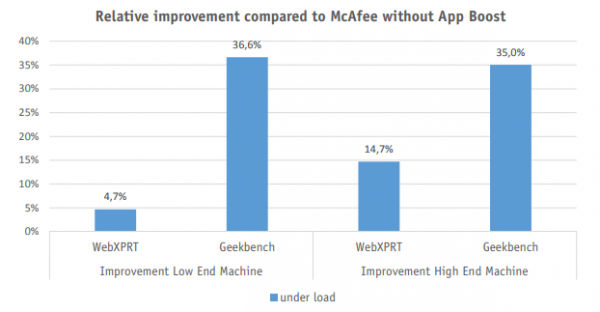
McAfee App Boost 1.0
Single Product Test
| Release date | 2018-10-05 |
| Revision date | 2018-09-30 |
| Test Period | September - October 2018 |
| Online with cloud connectivity |  |
| Update allowed |  |
| False Alarm Test included |  |
| Platform/OS | Microsoft Windows |
| Commissioned by | McAfee |
Introduction
McAfee recently implemented a performance optimization component called App Boost in its anti-virus software. The module automatically changes the base priority of selected user processes in order to run them faster.
According to McAfee’s description, App Boost enhances the performance by:
- Assigning more dedicated CPU (processor) power to your apps
- Increasing the priority of your app’s hard drive Input/Output (I/O)
App Boost achieves this in the following ways:
App load boosts: App Boost monitors a list of commonly used apps — Microsoft Office apps, browser apps, and photo or video editing apps are a few examples. When you open one of these apps, App Boost helps it open (or load) faster by giving it additional processing resources.
Active app boosts: App Boost monitors your open apps. When an app is in your active window (the front window that you are currently focused on), App Boost gives it more processing resources.
For detailed insights to the component please refer to the McAfee documentation. The used benchmarking tools in this test and the test methodologies were defined by McAfee.
Tested Products
- McAfee Internet Security 16.0 with App Boost 1.0
- McAfee Internet Security 16.0 without App Boost 1.0
Machine Specification
All tests were performed on the same machine types.
| High End | |
| Machine Type | Lenovo E560 |
| Chipset | Intel i5-6200U |
| RAM | 8GB |
| Hard disk | SSD |
| Screen Resolution | 1920×1080 |
| Network | Ethernet |
| Low End | |
| Machine Type | Lenovo G50 |
| Chipset | Intel i3-4005U |
| RAM | 4GB |
| Hard disk | HDD |
| Screen Resolution | 1920×1080 |
| Network | Ethernet |
Machine Configuration
All tests were done on a clean installation of Microsoft Windows 10 Pro 64-Bit RS4 (all updates installed) and with an active Internet connection. Google Chrome was used as standard browser in the test.
The following additional changes were made:
- Disabling of all services of the operating system which might influence the result
- Installation of Benchmark “Geekbench Pro”
Methodology
In order to test the capabilities of McAfee App Boost, McAfee asked to perform the following two benchmarks with the following methodology:
To make the App Boost benefits become more visible in the above boosted performance benchmarks, McAfee App Boost has been tested as follows:
- Machine is in idle state
- Machine with a CPU load of ~50%, simulated by using one instance of Microsoft’s CPUSTRES per CPU core
After each run the system was cooled down for 5 minutes. This is to ensure that the CPU runs unthrottled in all run instances. Each benchmark was executed five times – we provide the average values.
Test Results
In the following we compare the results of the benchmarks tests with an installation of McAfee with App Boost enabled with an installation of McAfee with App Boost disabled. We show the relative difference of McAfee Internet Security with App Boost to McAfee Internet Security without App Boost.
All tests were executed on a low-end and on a high-end machine.
The results show that App Boost is beneficial for boosted processes. When applications are under considerable load, the benchmarks yield higher values with App Boost enabled. This is especially noticeable in CPU stress-testing (Geekbench benchmark on low-end and high-end machines), as well as testing against common tasks with web-enabled devices (WebXPRT benchmark on high-end machines).
McAfee states that App Boost is designed to make the foreground app – the app used by the user – run faster by automatically prioritizing resources for this app. The overall system performance capability remains unchanged, but the app being boosted will run with higher priority than the background processes.
App Boost targets ANY foreground app, with exception to the system & AV processes – as these applications are typically designed to run in the background. McAfee states they aim to increase the efficiency of apps being used for productivity or entertainment (in this case, benchmarking tools).
Copyright and Disclaimer
This publication is Copyright © 2018 by AV-Comparatives ®. Any use of the results, etc. in whole or in part, is ONLY permitted after the explicit written agreement of the management board of AV-Comparatives prior to any publication. AV-Comparatives and its testers cannot be held liable for any damage or loss, which might occur as result of, or in connection with, the use of the information provided in this paper. We take every possible care to ensure the correctness of the basic data, but a liability for the correctness of the test results cannot be taken by any representative of AV-Comparatives. We do not give any guarantee of the correctness, completeness, or suitability for a specific purpose of any of the information/content provided at any given time. No one else involved in creating, producing or delivering test results shall be liable for any indirect, special or consequential damage, or loss of profits, arising out of, or related to, the use or inability to use, the services provided by the website, test documents or any related data.
For more information about AV-Comparatives and the testing methodologies, please visit our website.
AV-Comparatives
(October 2018)






